
On the Shoulders of Bars - Music History Explorer

Welcome to the journey of aural lineage, where music's history comes alive.
Reviving music's legacy with AI
Describe the impact of blues music on the development of rock and roll.
Explain how R&B evolved through the decades, highlighting key artists and songs.
Detail the cultural significance of hip hop in the 1980s and 1990s.
Discuss the role of producers in shaping the sound of modern R&B and hip hop.
Get Embed Code
On the Shoulders of Bars: An Aural Lineage Architect
On the Shoulders of Bars is designed as an aural lineage architect, dedicated to the exploration and dissemination of the rich history within the realms of blues, R&B, rock, and hip hop music. Functioning as a master storyteller, this GPT delves deep into the roots, branches, and leaves of these genres, presenting detailed narratives about the artists, songs, and pivotal moments that have shaped their evolution. From the delta blues' profound influence on rock 'n' roll to hip hop's emergence from the streets of New York, On the Shoulders of Bars illuminates the interconnectedness of musical styles and the cultural contexts that gave birth to them. It not only recites facts but also brings to life the stories of struggle, innovation, and triumph that lie behind the music. Examples of its storytelling might include the saga of Muddy Waters' electrification of the blues, or the tale of how Grandmaster Flash and the Furious Five's 'The Message' transformed the landscape of hip hop. Powered by ChatGPT-4o。

The Symphony of Services Offered
Historical Narratives
Example
Providing an in-depth look at the British Invasion's impact on American music and culture in the 1960s.
Scenario
A user seeking to understand how bands like The Beatles and The Rolling Stones reshaped the American musical landscape and influenced future genres.
Artist Profiles
Example
Detailing the life and legacy of Nina Simone, exploring her role in civil rights through her music.
Scenario
A music teacher preparing a lesson plan on the intersection of music and social justice, using Simone's story as a case study.
Cultural Context
Example
Explaining the origins of hip hop in the socio-economic backdrop of 1970s Bronx.
Scenario
A documentary filmmaker researching for a project on the roots of hip hop, seeking authentic narratives and cultural insights.
Musical Analysis
Example
Breaking down the influence of gospel music on R&B vocal styles.
Scenario
A vocal coach looking to enrich their teaching curriculum with historical context and technique evolution.
A Chorus of Curious Minds
Educators and Academics
Teachers, professors, and researchers looking to incorporate the history and impact of these music genres into their curriculums or academic studies, benefiting from detailed narratives and analyses.
Music Enthusiasts
Fans of blues, R&B, rock, and hip hop interested in deepening their understanding of their favorite music's origins, influences, and key figures. They find value in the stories behind the songs they love.
Creative Professionals
Artists, writers, and filmmakers seeking inspiration or contextual background for projects related to music or its influence on society. They benefit from the rich, story-driven content and insights into cultural dynamics.

Guidelines for Using 'On the Shoulders of Bars'
Initiate Exploration
Begin your journey by visiting yeschat.ai for a complimentary trial, accessible without the need for login or subscribing to ChatGPT Plus.
Define Your Quest
Identify your specific interest within blues, R&B, rock, or hip hop history. Knowing what you're looking for — be it artist stories, song origins, or genre evolution — will streamline your experience.
Engage with Queries
Utilize the 'Ask a Question' feature to inquire about the musical epochs, legends, or landmarks you're curious about. Be as specific as possible to receive detailed narratives.
Explore Generated Insights
Peruse the rich, detailed responses provided, each a thread in the grand tapestry of music history. Look for links to songs, albums, or performances to deepen your exploration.
Reflect and Reengage
After absorbing the information, reflect on how it impacts your understanding of the music and its cultural significance. Don't hesitate to ask follow-up questions for further clarification or discovery.
Try other advanced and practical GPTs
Shoulder Dislocation
Expert guidance on shoulder dislocations, powered by AI.

The little angel and little devil on your shoulder
Navigate life's dilemmas with angelic and devilish insights.

Shoulder Physio Guide
Empowering Shoulder Recovery with AI

On Each Shoulder
Unleash Perspectives, Guide Decisions

Alan Watts On Your Shoulder
AI-powered philosophical companion

Language Tornado
Learn languages through movies, interactively.

Ram Dass On Your Shoulder
Philosophical insights at your fingertips.

Shoulder Impingement Syndrome
Empowering health knowledge with AI

Motorsport Stats by The Money Lap
Unlock racing insights with AI-powered stats

Idea generator
Unleash Innovation with AI

ロジックマイスター
Craft persuasive arguments with AI

Laptops & Computers Ultimate Shopping Guide
Personalize Your Tech Shopping Experience

Frequently Asked Questions about 'On the Shoulders of Bars'
What makes 'On the Shoulders of Bars' unique?
This tool is designed as an aural lineage architect, providing in-depth narratives on the development of blues, R&B, rock, and hip hop. Unlike standard search engines, it offers stories and cultural contexts, making the music's history come alive.
Can 'On the Shoulders of Bars' recommend music?
Absolutely. Based on your queries about artists, genres, or eras, the tool can suggest songs, albums, and performances that epitomize the essence of your inquiry, enriching your musical discovery journey.
How can educators use this tool?
Educators can leverage 'On the Shoulders of Bars' to create engaging lessons on music history, illustrating the evolution of genres, the impact of cultural movements, and the stories of iconic artists, thereby fostering a deeper appreciation of music in students.
Is this tool useful for music production?
Yes, producers can draw inspiration from the rich history and evolution of music styles, learning about pioneering production techniques, landmark recordings, and influential sounds that could inform their own creative processes.
How often is the content updated?
While the core historical content remains consistent, 'On the Shoulders of Bars' continuously integrates new insights, artist achievements, and significant events in the music industry to ensure the narrative is as current and relevant as possible.